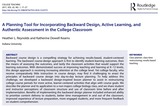
ABSTRACT: Backward course design is a compelling strategy for achieving results-based, student-centered learning. The backward course-design approach is first to identify student-learning outcomes, then the means of assessing the outcomes, and lastly the classroom activities that would support the learning outcomes. With demonstrated success at improving teaching and learning at K–12 levels, this design approach is receiving increasing attention at the college level. Yet college faculty, who receive comparatively little instruction in course design, may find it challenging to enact the principles of backward course design into day-to-day lecture planning. To help address this challenge, we developed a backward design-inspired lesson planner to assist in restructuring college course periods for more active, learner-centered activities that align with course goals. We describe the planner and its application to a non-majors college biology class, and we share student and instructor perceptions of classroom structure and use of classroom time before and after implementation. Benefits of implementing the backward design planner included enhanced ability to prioritize content delivery to students, better time management in and out of the classroom, improved experience of lecture preparation, more engaged students, and more frequent feedback on student comprehension.
- Subject:
- Education
- Material Type:
- Primary Source
- Author:
- Katherine Dowell Kearns
- Heather L. Reynolds
- Date Added:
- 05/10/2022